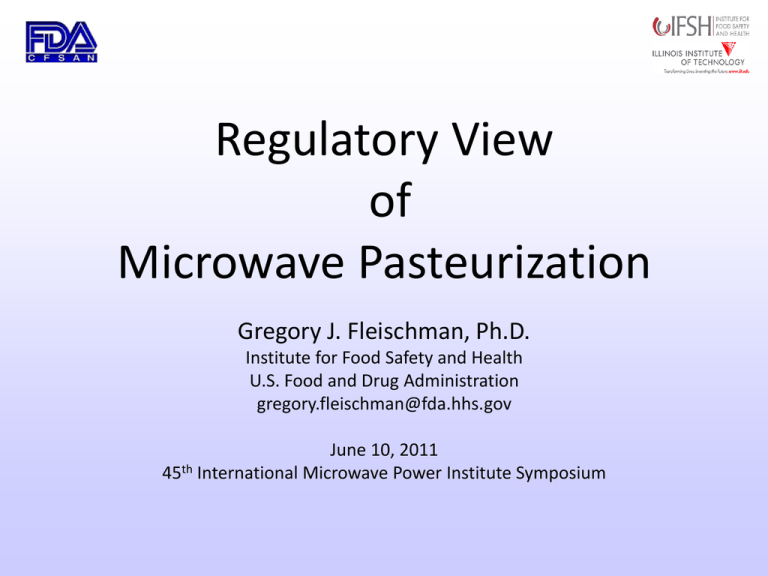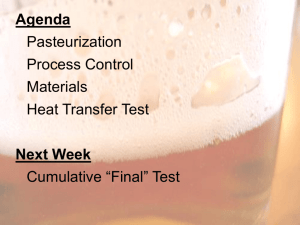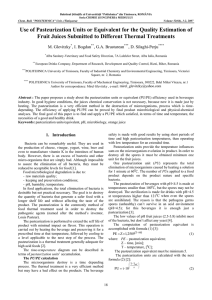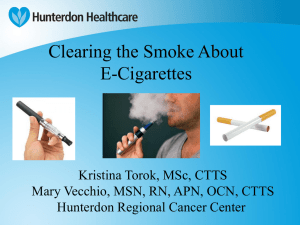Regulatory View of MW Pasteurization
advertisement

Regulatory View of Microwave Pasteurization Gregory J. Fleischman, Ph.D. Institute for Food Safety and Health U.S. Food and Drug Administration gregory.fleischman@fda.hhs.gov June 10, 2011 45th International Microwave Power Institute Symposium FDA and USDA FDA regulates… foods except meat and poultry products food products containing less than 2 percent cooked meat/poultry and containing less than 3 percent raw meat. the manufacturing of meat sauces and most soups game meat (e.g., venison, ostrich and snake) eggs after inspection USDA regulates most meat and poultry eggs at the production level Pasteurization Defined in Section 403 of the Federal Food, Drug, and Cosmetic (FD&C) Act [21 U.S.C. 343] as amended by the 2002 Farm Bill Interpretation: “Any process, treatment, or combination thereof, that is applied to food to reduce the most resistant microorganism(s) of public health significance to a level that is not likely to present a public health risk under normal conditions of distribution and storage.” National Advisory Committee on Microbiological Criteria for Foods. 2006. Journal of Food Protection, Vol. 69, No. 5, 2006, Pages 1190–1216 Milk Examples governed by the Pasteurized Milk Ordinance (PMO) the PMO is prescriptive, stipulates time/temperature requirements target organism: originally Mycobacterium tuberculosis, now Coxiella burnetii Juice governed by the Juice HACCP Regulation (21 CFR 120.24(a)) each juice requires its own HACCP plan target organism: variable, and may be other contaminants as well, e.g., chemical contaminants Eggs governed by the 2009 Egg Safety Action Plan (21 CFR Parts 16 and 118) Producers are exempt from 6 of 7 provisions of this plan by pasteurizing eggs Target organism: Salmonella Enteritidis Microwave Pasteurization 21 CFR 179.30 Radio frequency radiation, including microwave frequencies, may be safely used for heating food under the following conditions: The radiation source consists of electronic equipment producing radio waves with specific frequencies for this purpose authorized by the Federal Communications Commission. The radiation is used or intended for use in the production of heat in food wherever heat is necessary and effective in the treatment or processing of food. Achieving Pasteurization Talk to FDA concerning process goal Identify target organism(s) Determine level of inactivation required • determine initial potential bacterial load • establish variations in this load Determine the effect of the food matrix on organism survivability Insure that process does not create a hazard as a consequence to pasteurization Validate the process Verify the process Submit findings to FDA Achieving Pasteurization Talk to FDA concerning process goal Identify target organism(s) Determine level of inactivation required • determine initial potential bacterial load • establish variations in this load Determine the effect of the food matrix on organism survivability Insure that process does not create a hazard as a consequence to pasteurization Validate the process Verify the process Submit findings to FDA Validation and Verification of Pasteurization Processes Validation = does your process work? demonstrate that pasteurization is achieved throughout food establish critical factors and their acceptable range establish means to monitor critical factors insure that validation procedure doesn’t change process Verification = does it keep working? monitor critical factors Potential Critical Factors in Microwave Pasteurization Food factors • composition • physical characteristics (shape, size, volume) • physical state (liquid, solid, ice) • changing product parameters (e.g., specific heat) Process factors • power level and cycling • process time • equilibration time Equipment factors -- magnetron frequency and age Packaging -- effect on process delivery The Microwave Validation Challenge Continuous processing (liquids) is straightforward adequate mixing assures uniform temperatures downstream direct measurement of temperature levels Discrete processing (individual packages) is not straightforward non-uniform temperatures only indirect assessment of temperature levels possible example: microwave pasteurization of shell eggs Shell Egg Pasteurization Uniformly inoculated egg Clear vs. Cloudy albumen FDA Review FDA doesn’t… • prescribe validation protocol • approve processes FDA does… advise producers on what is expected in a validation protocol review validation protocol Issues a letter of no objection if validation protocol is deemed sufficient to support pasteurization claim










